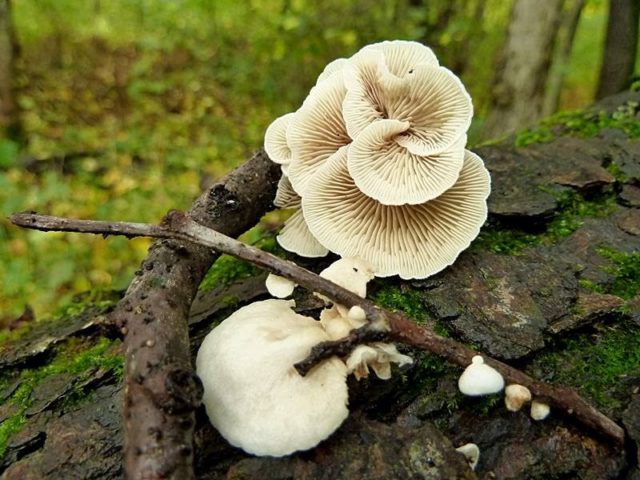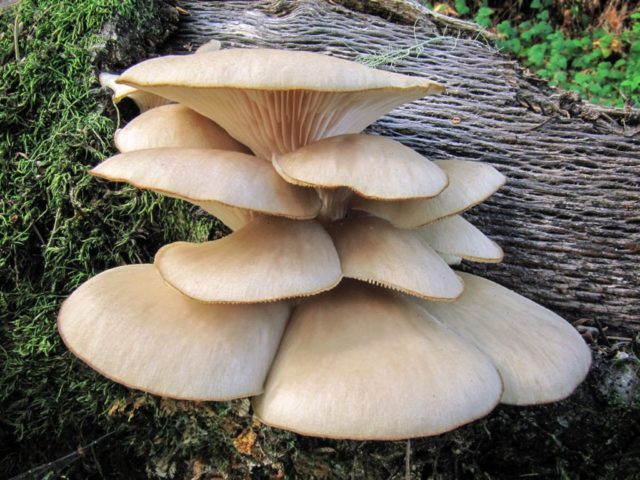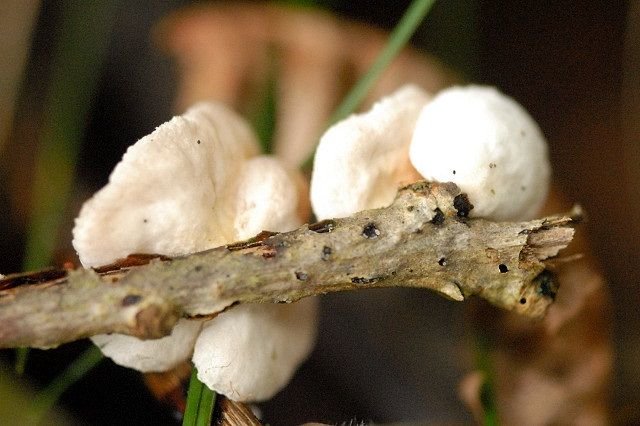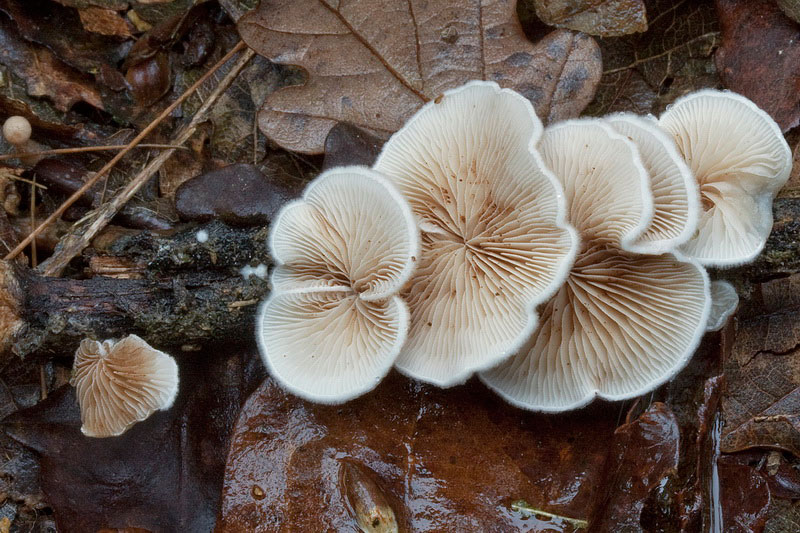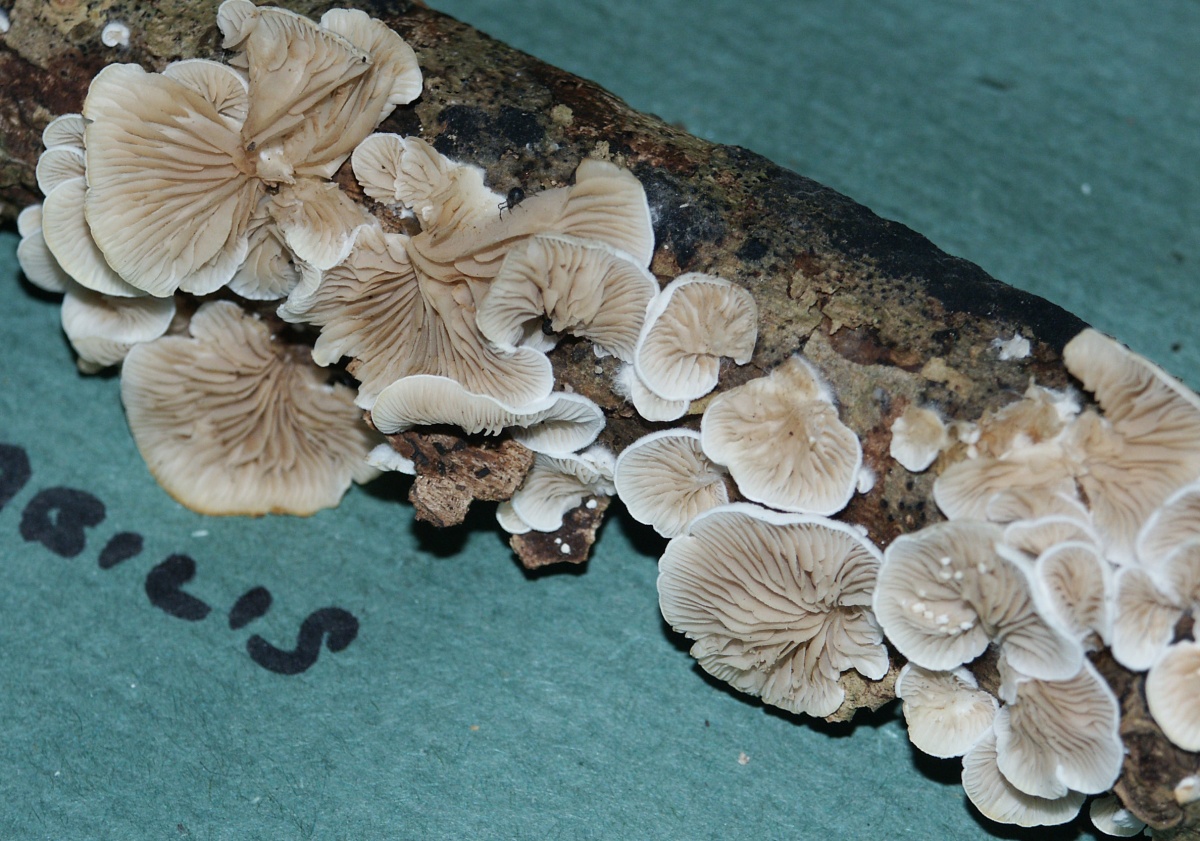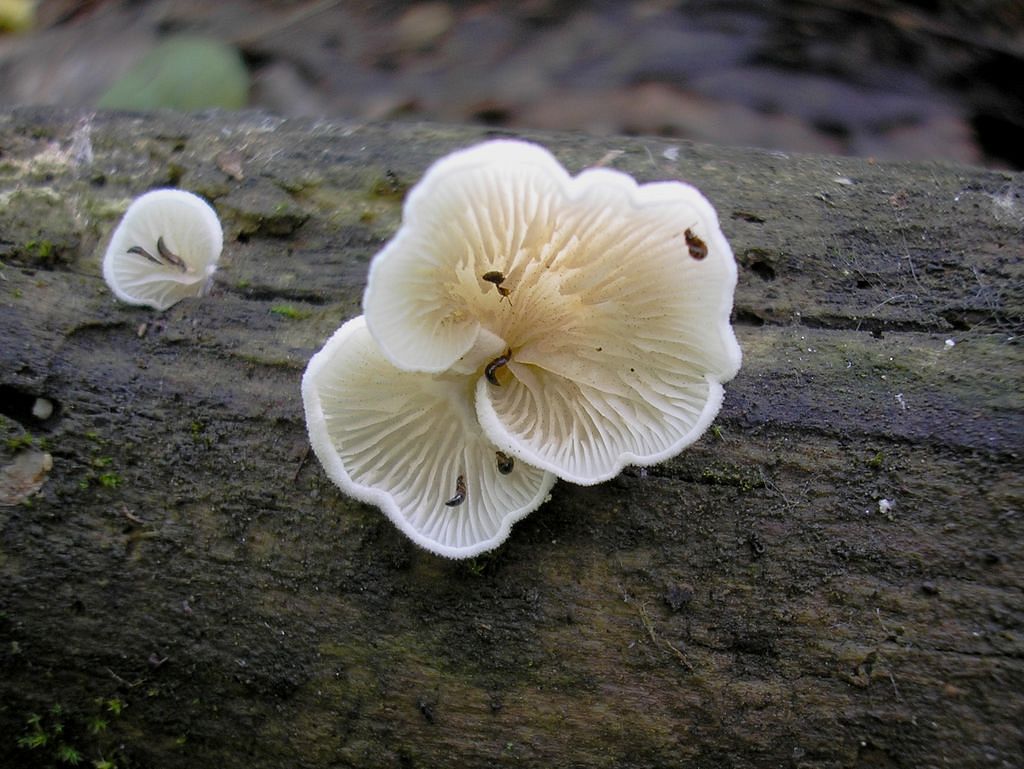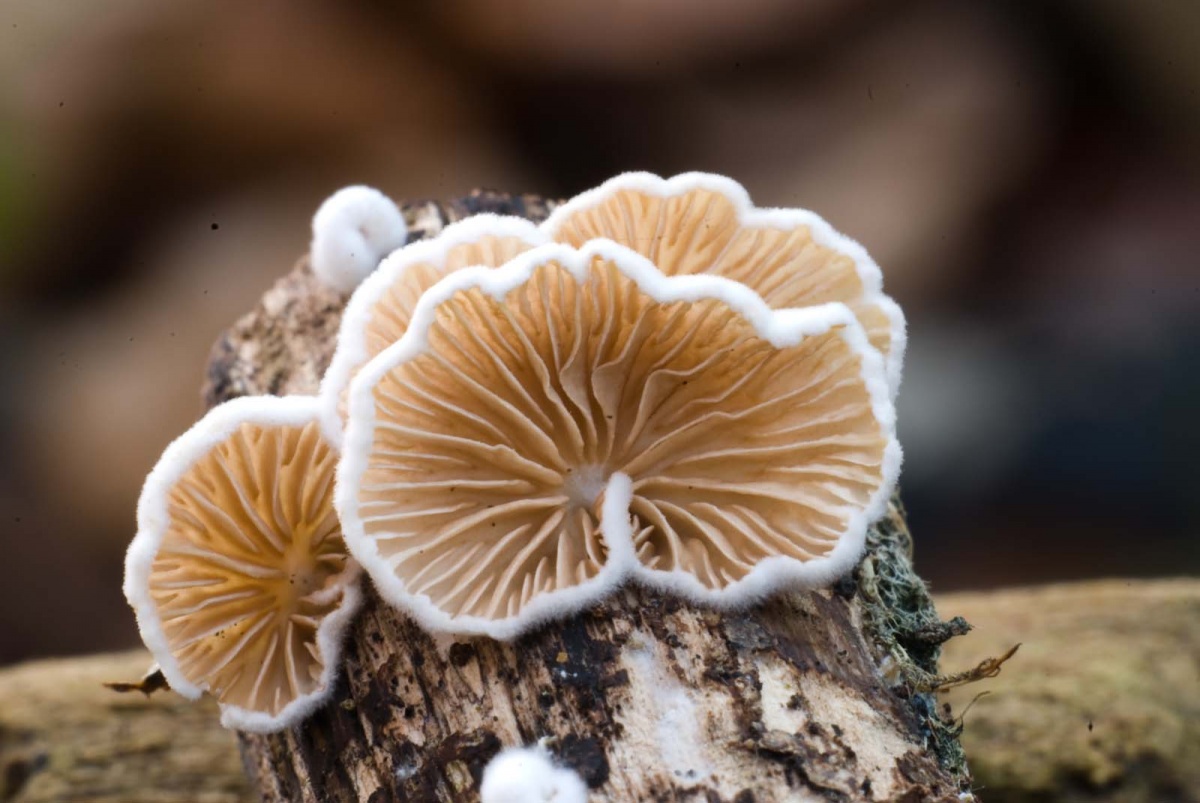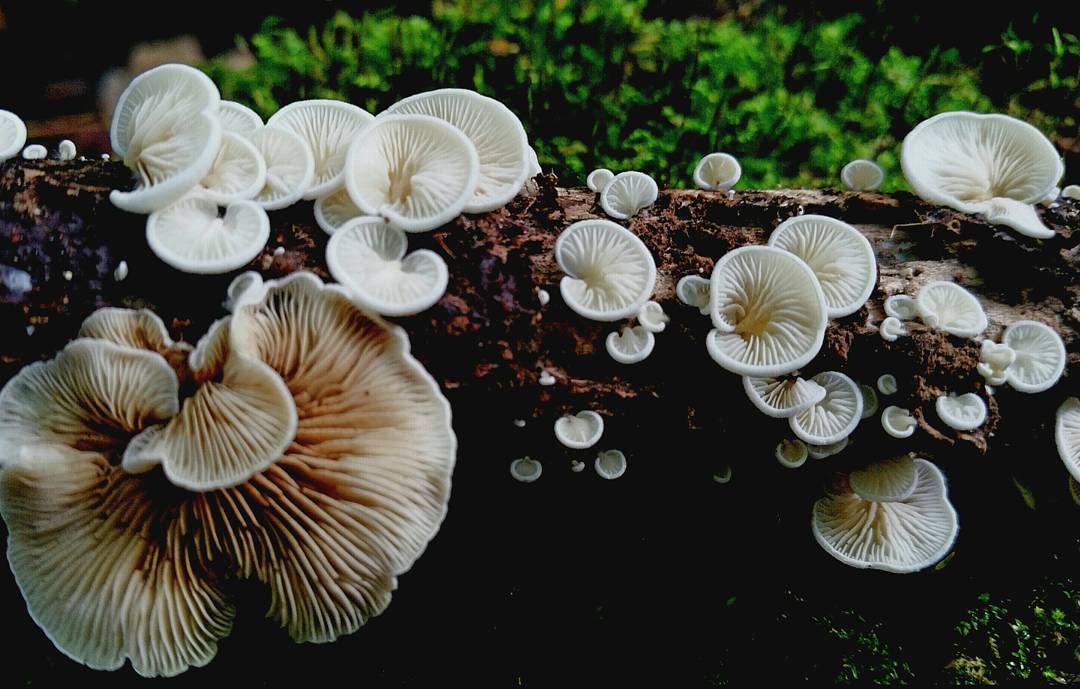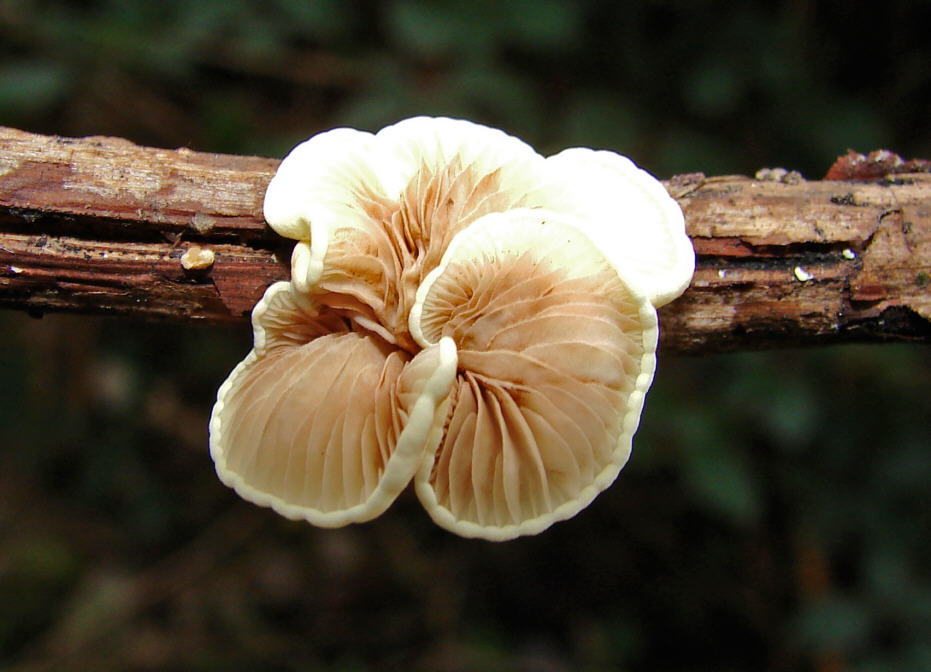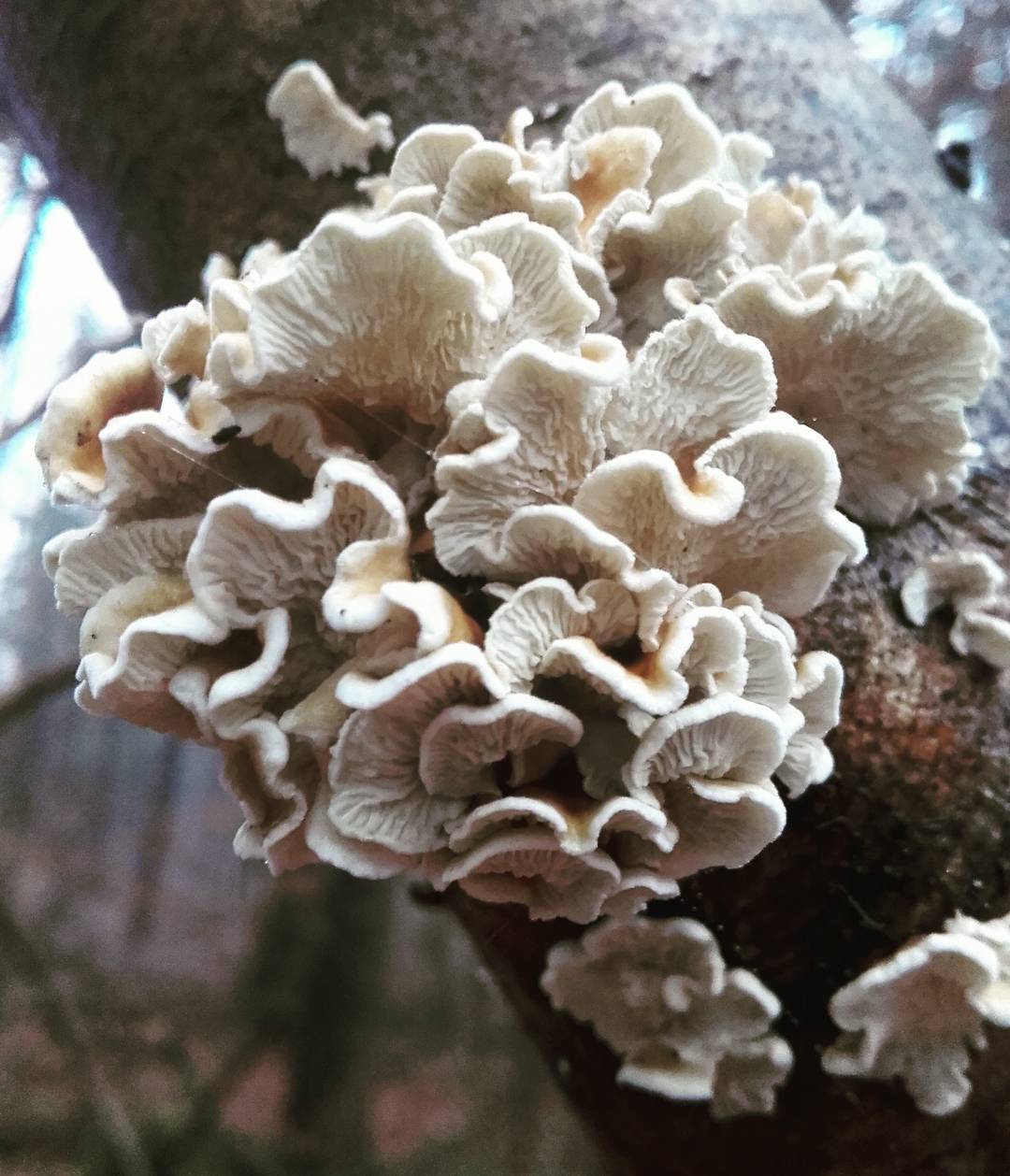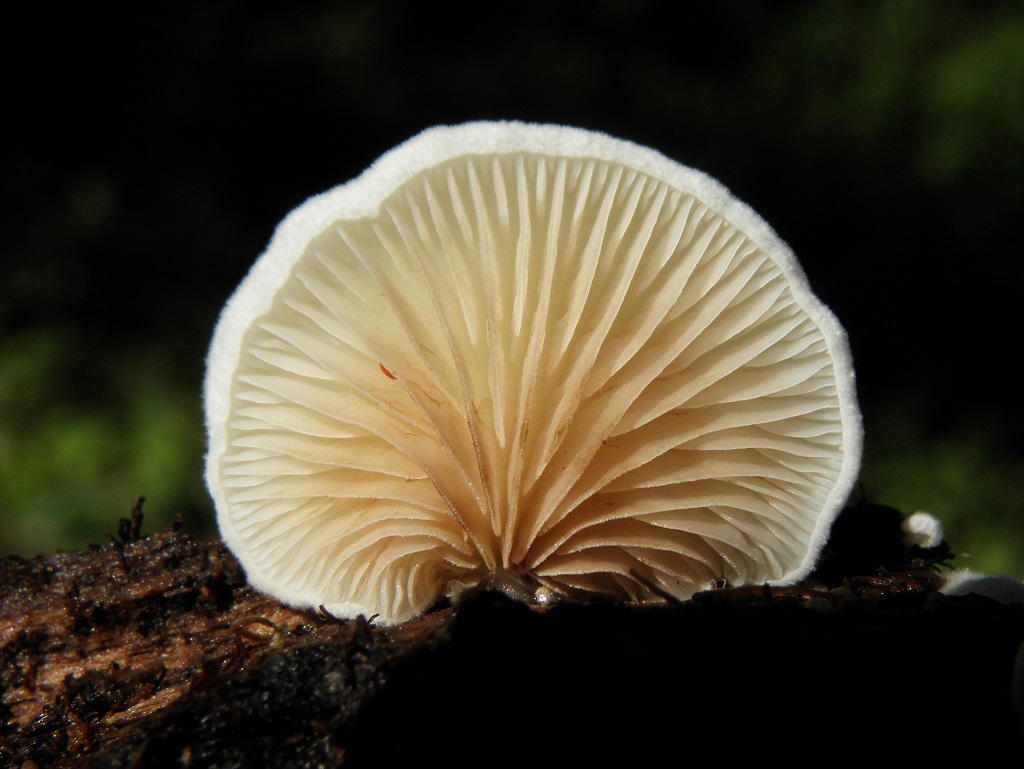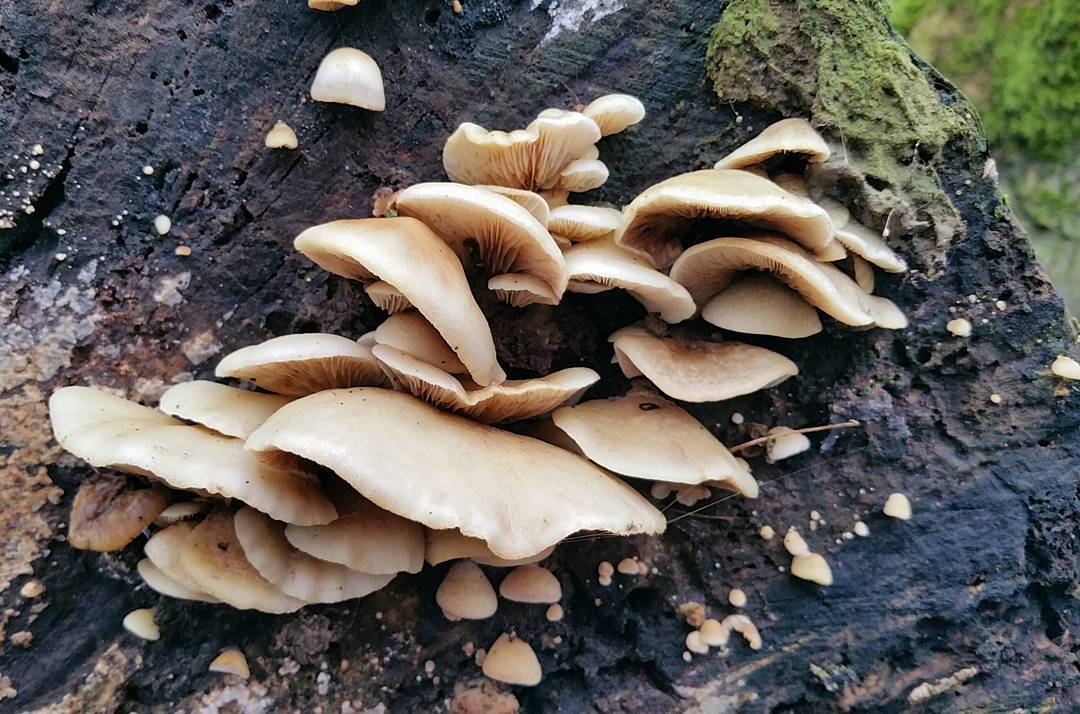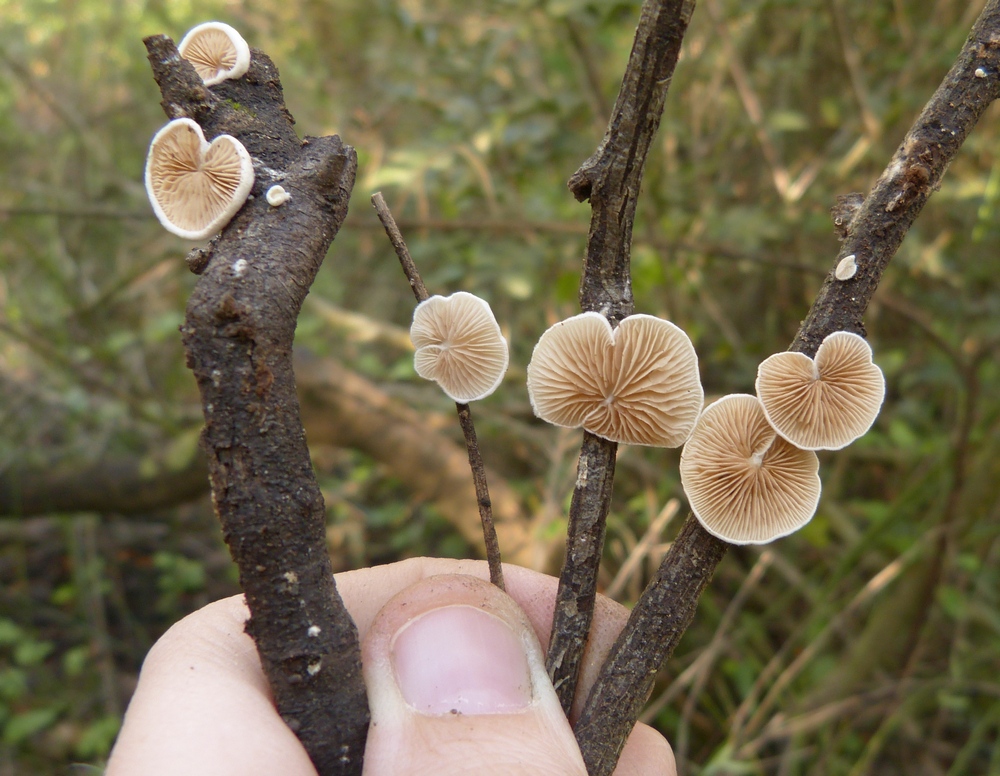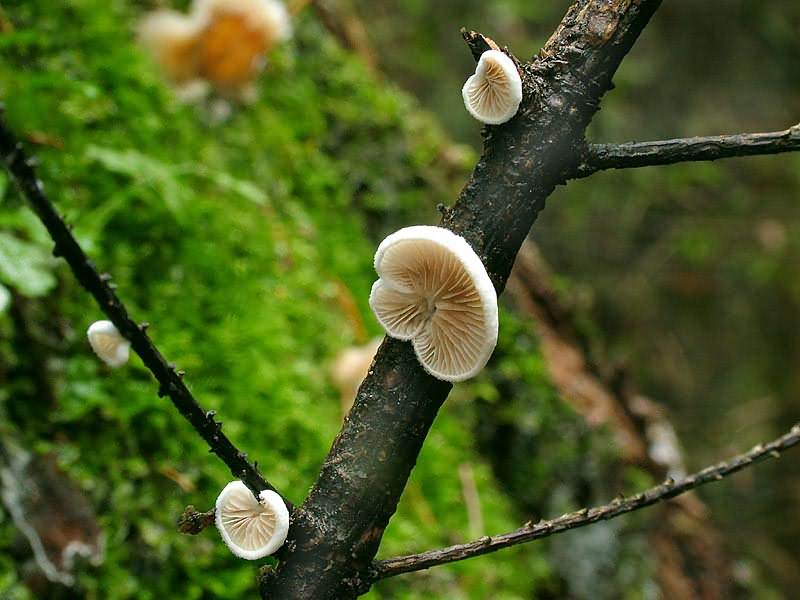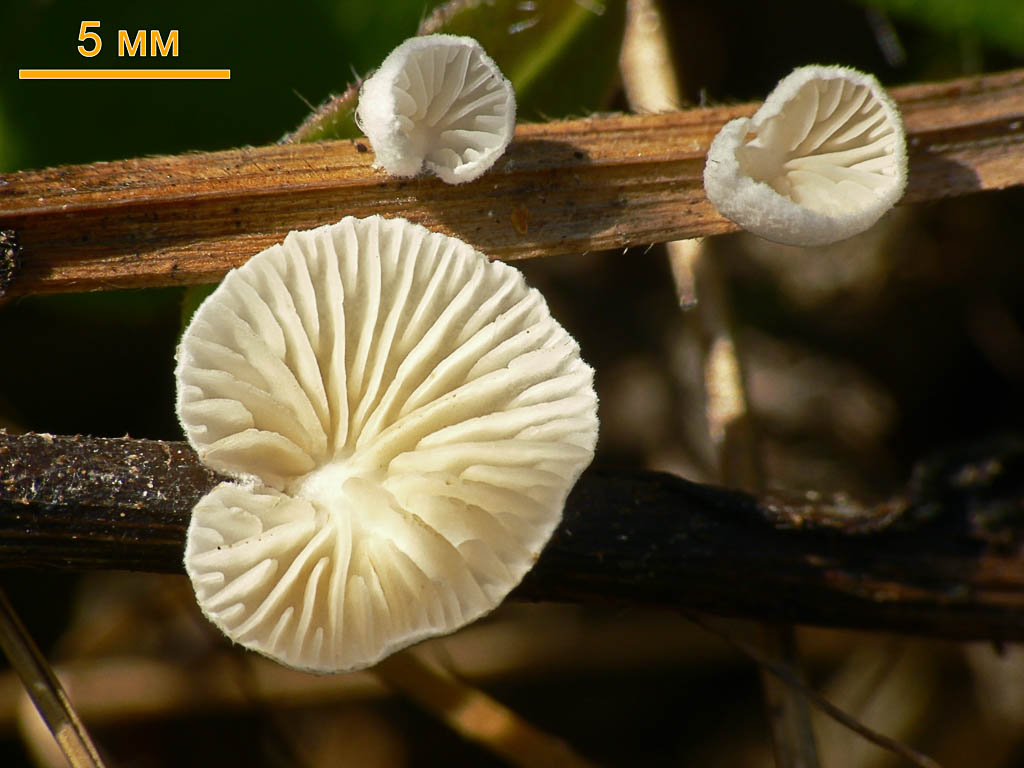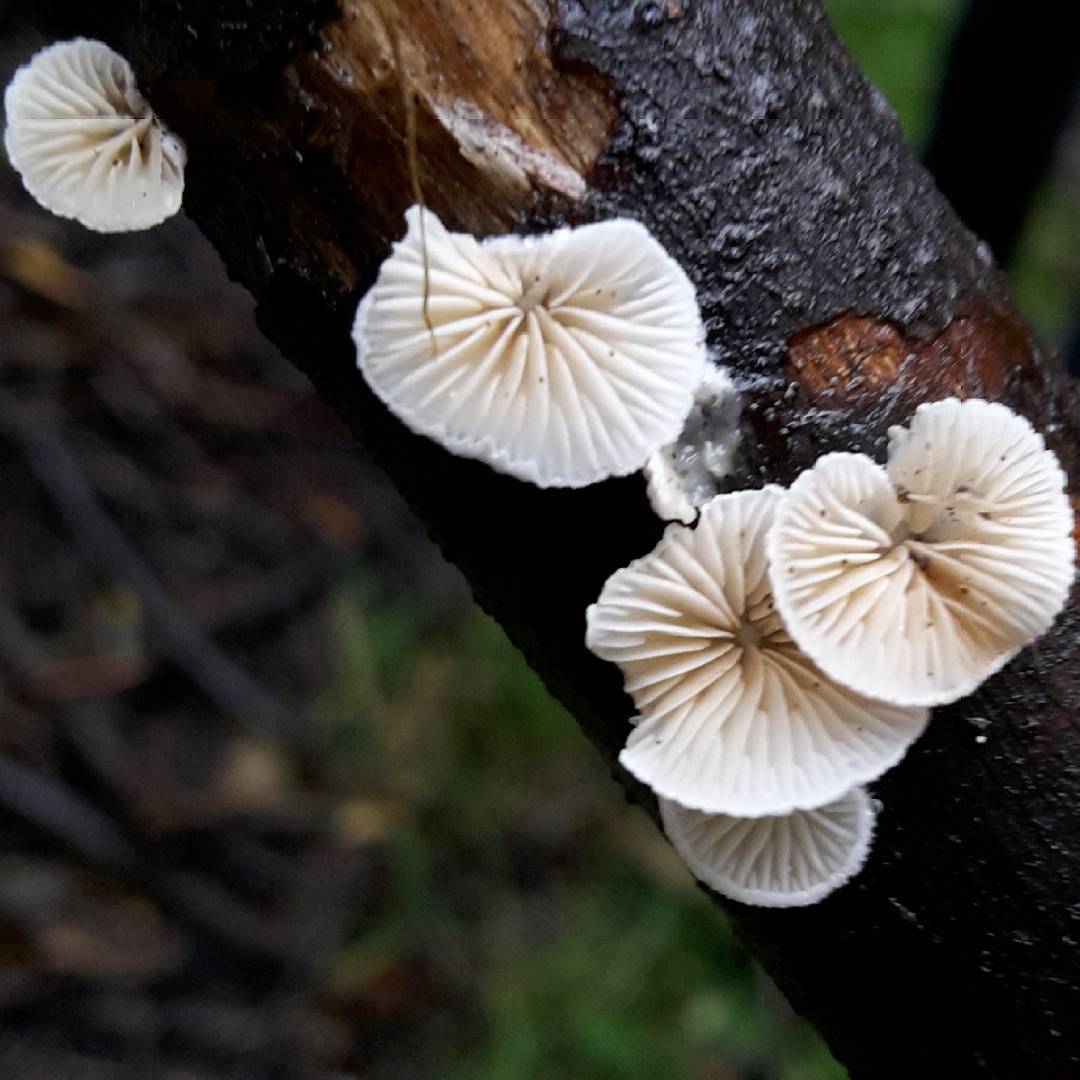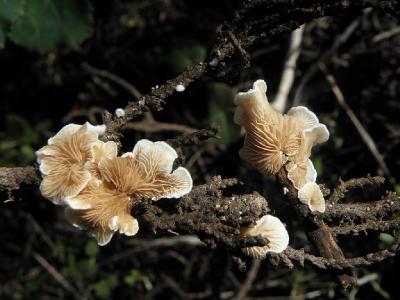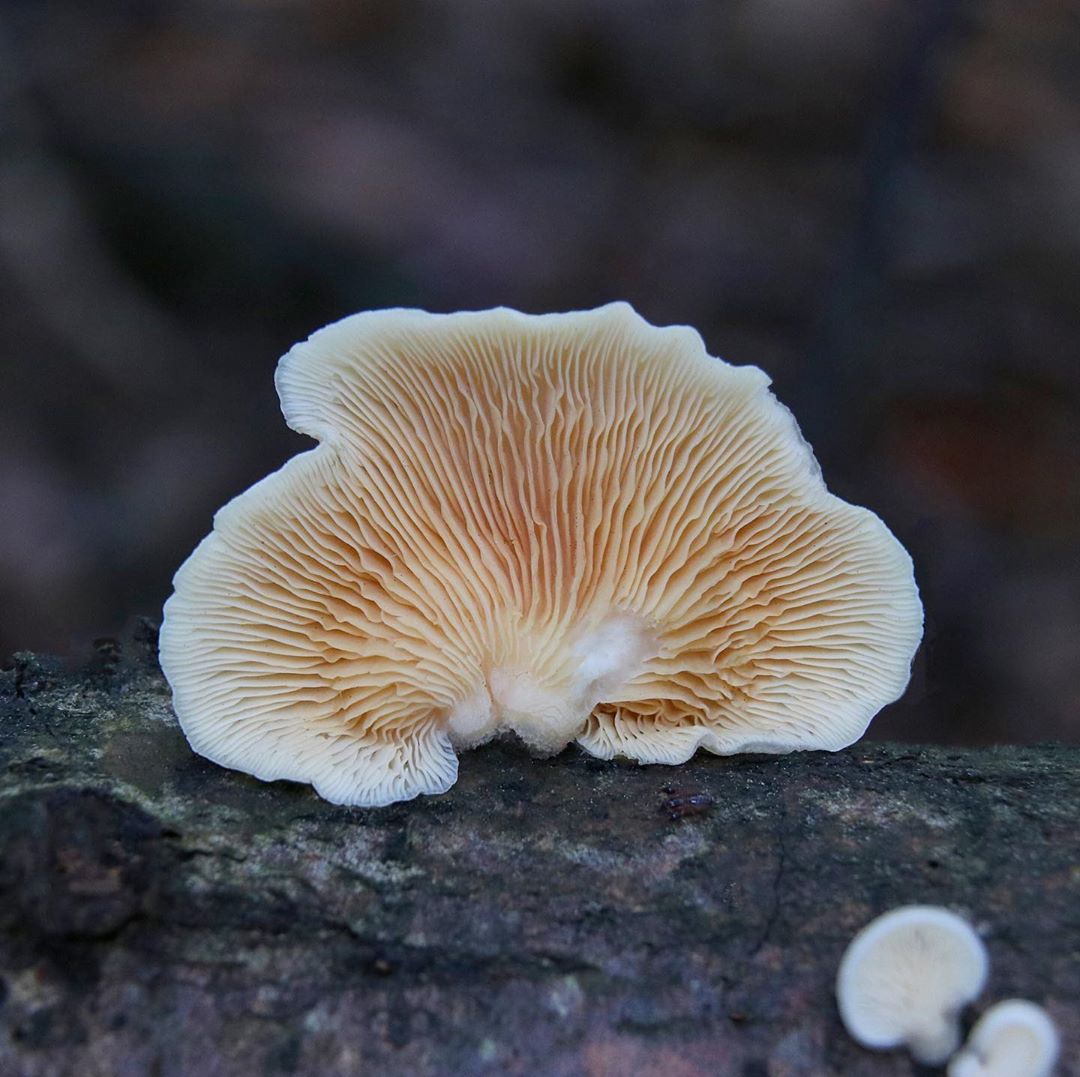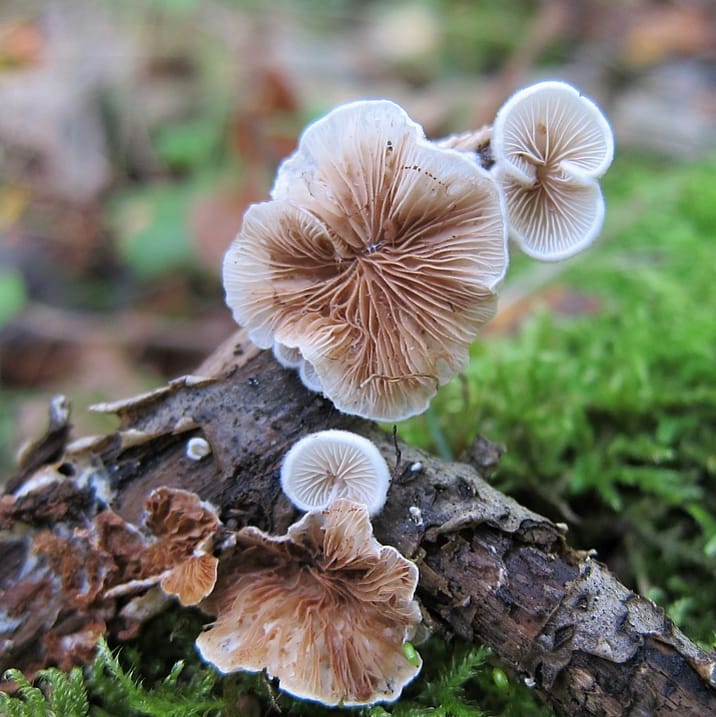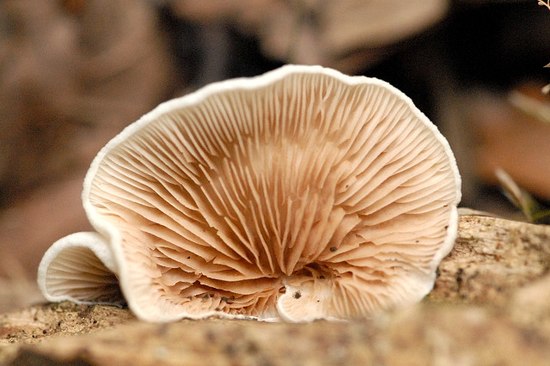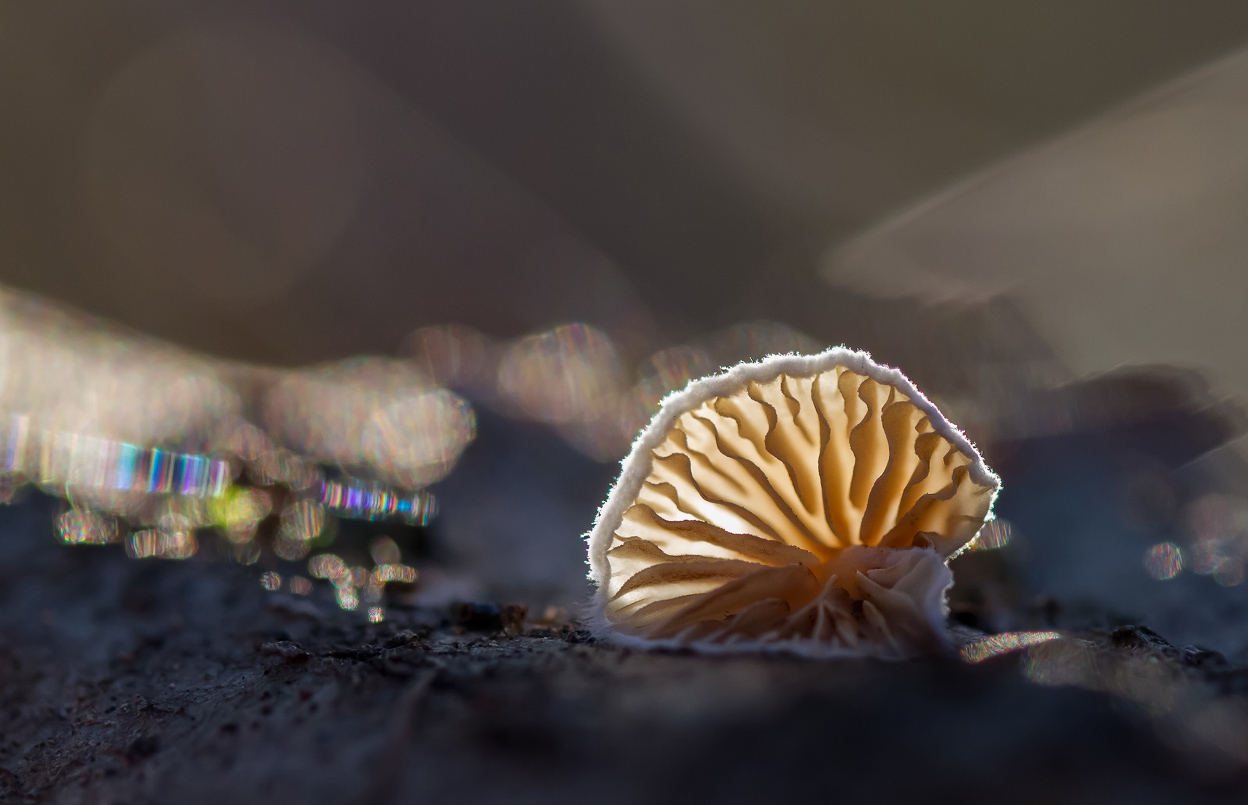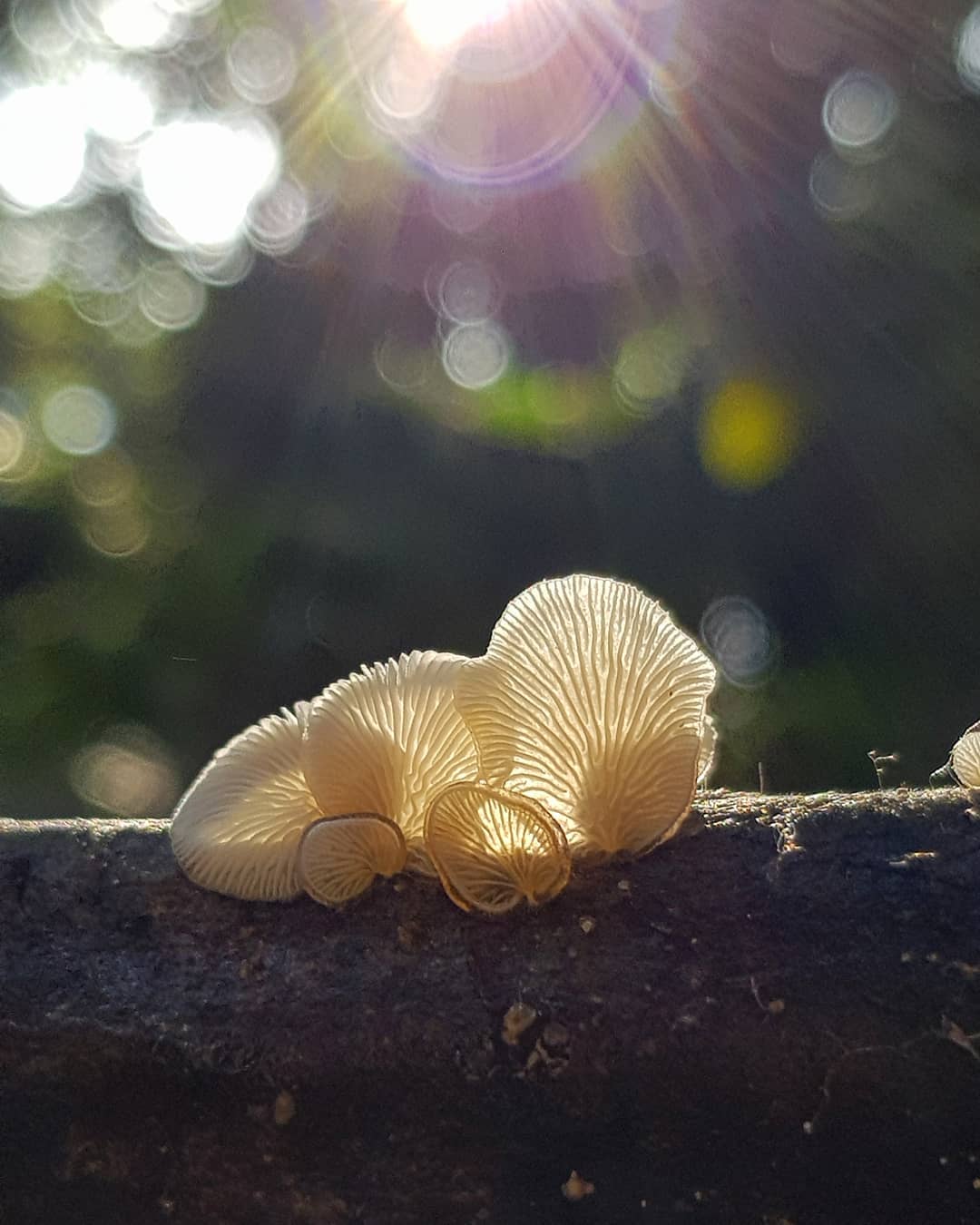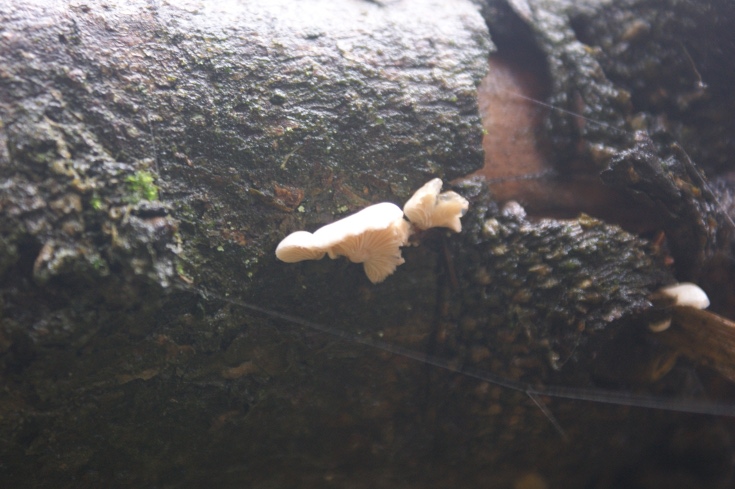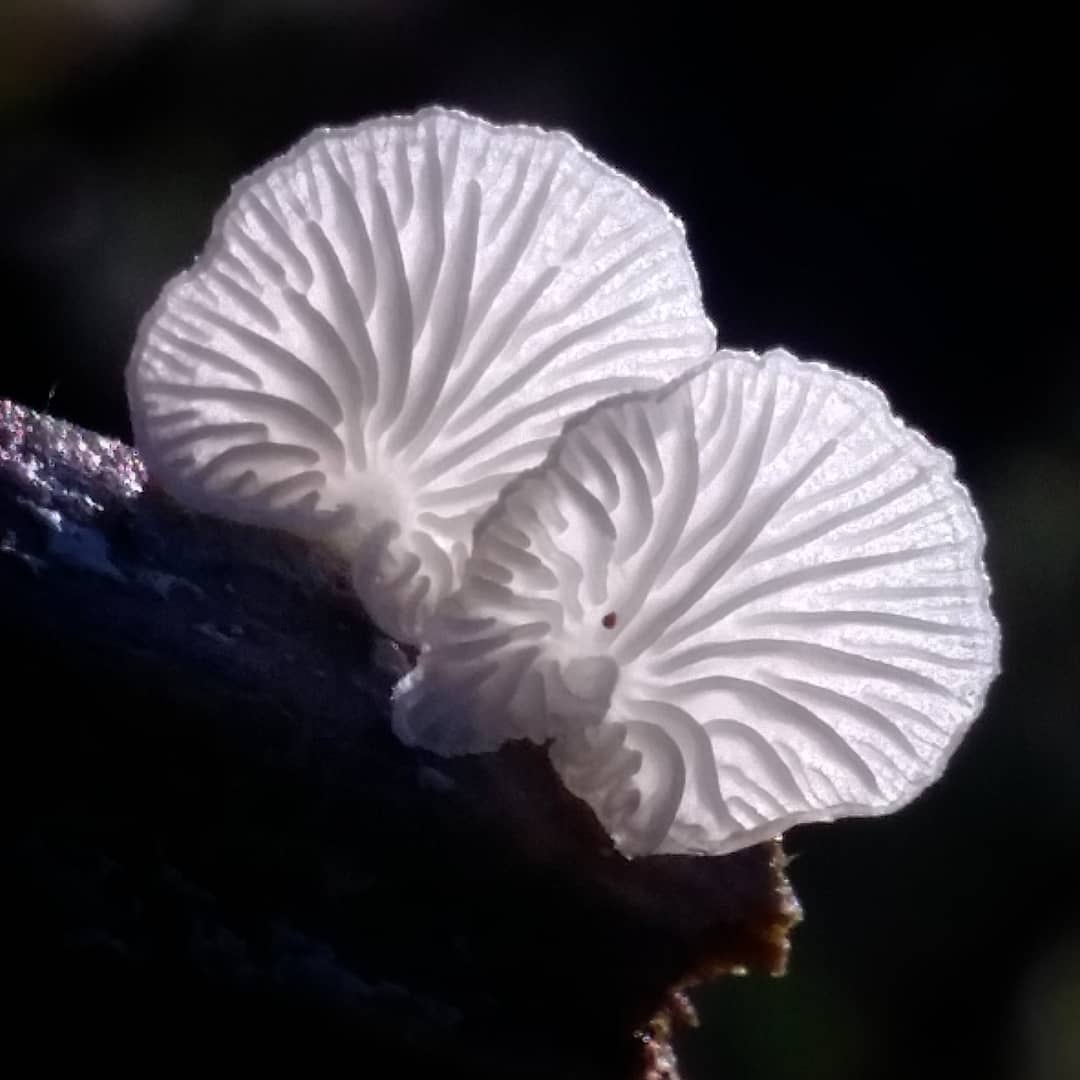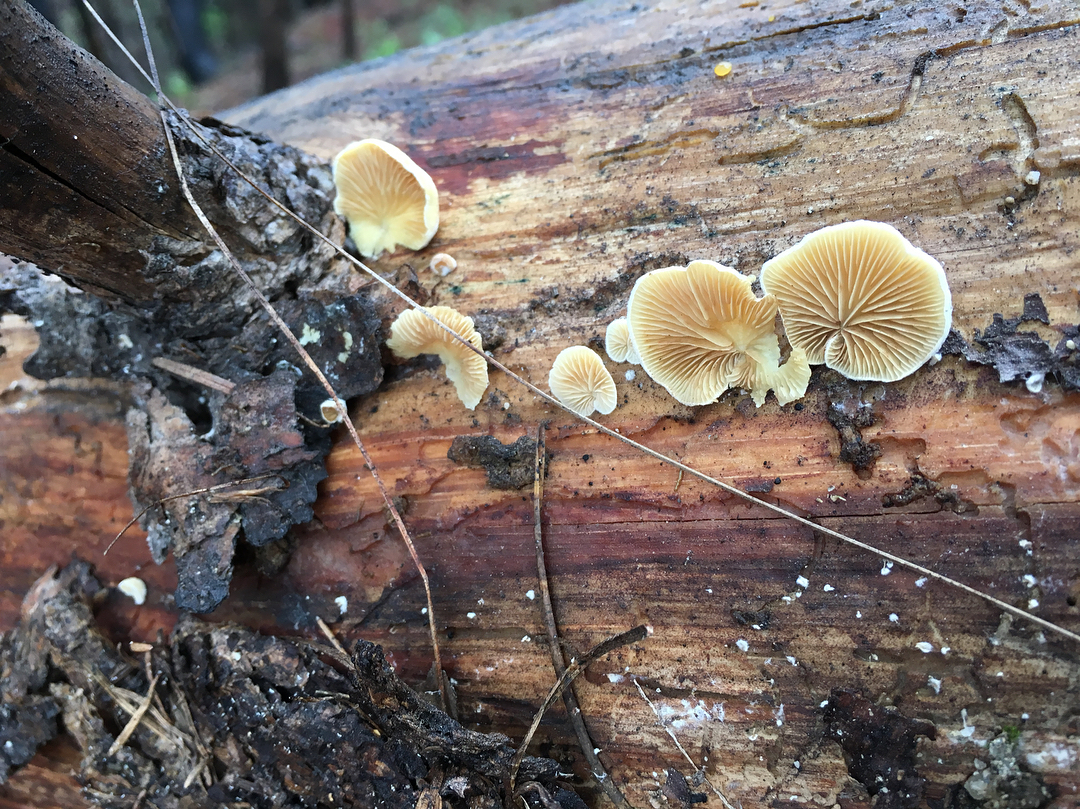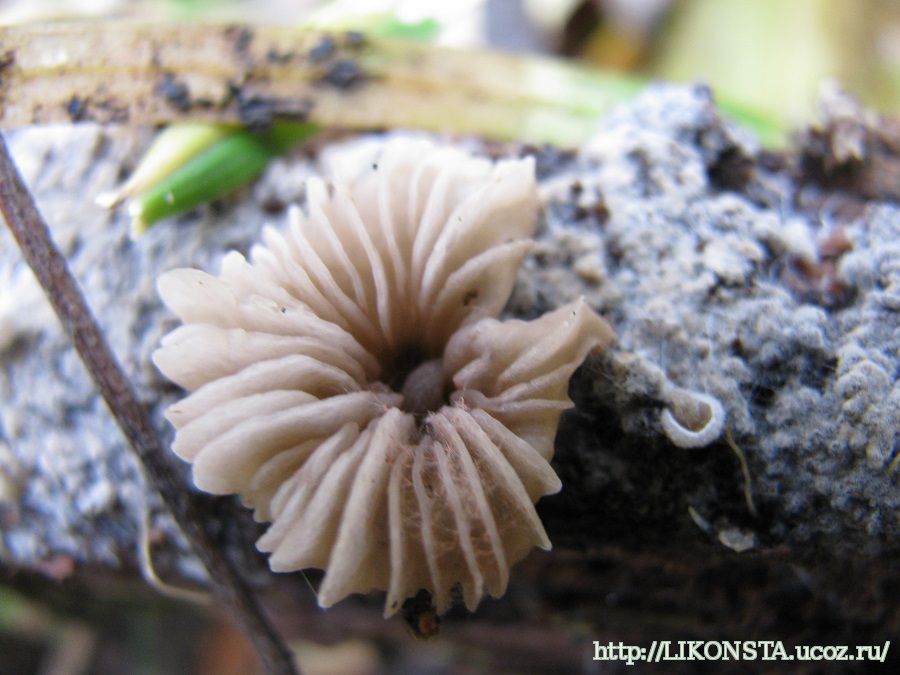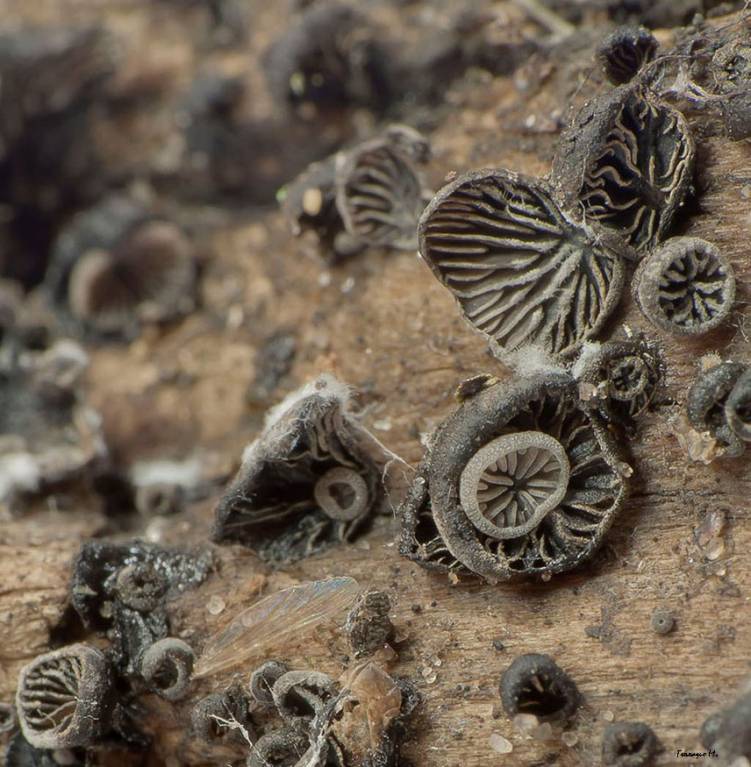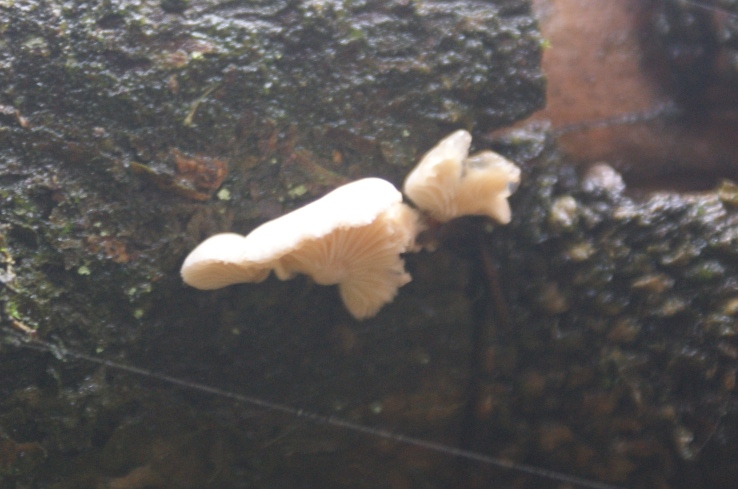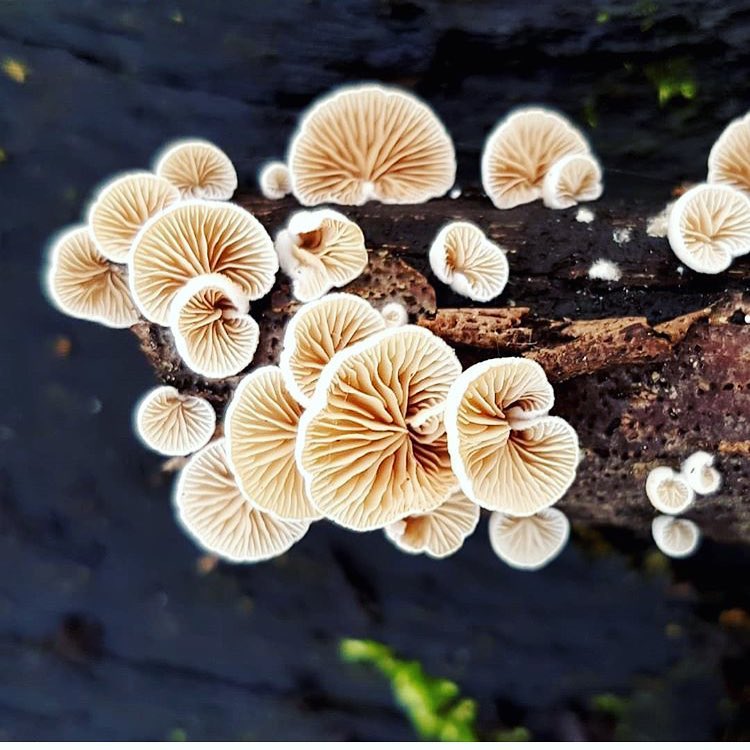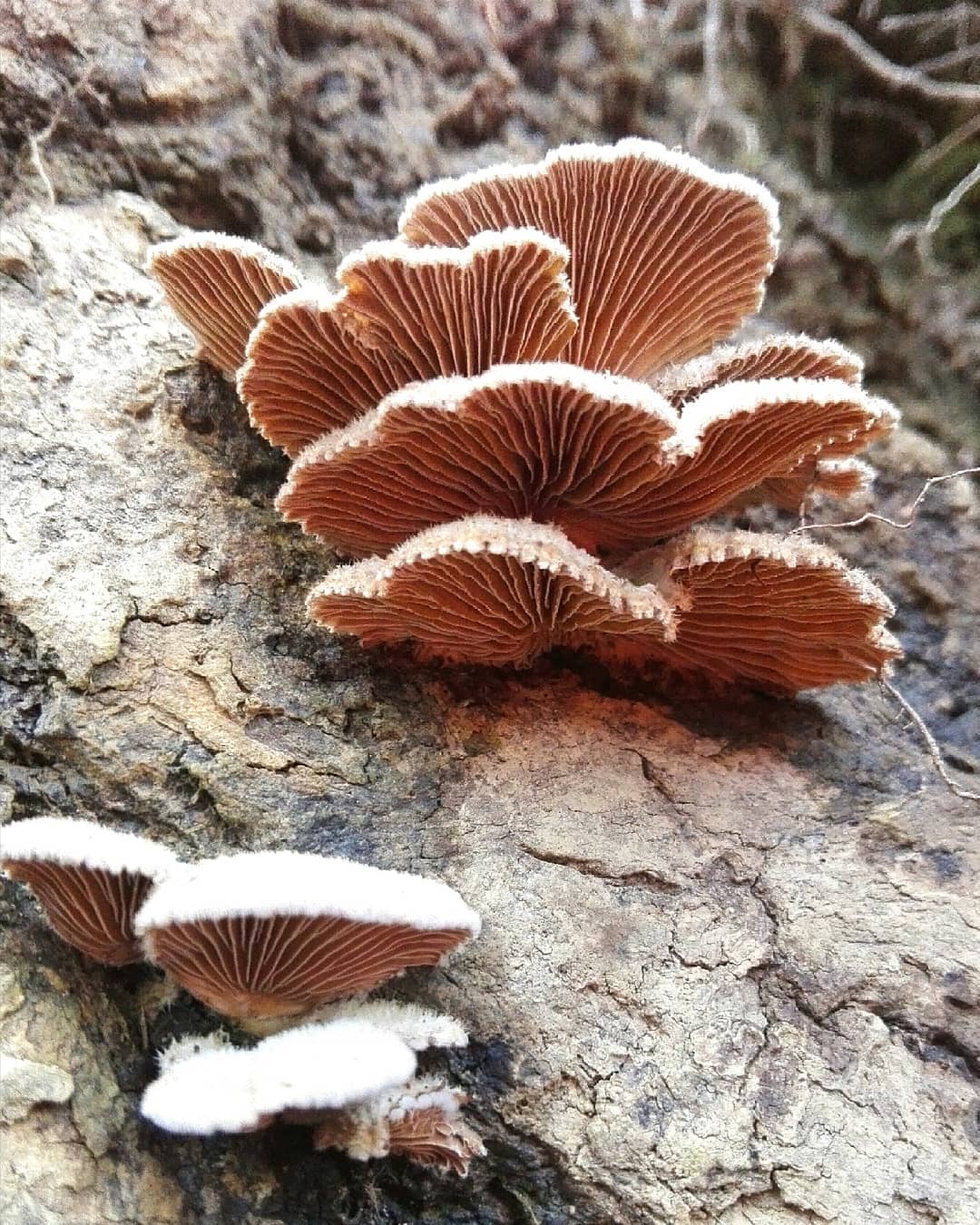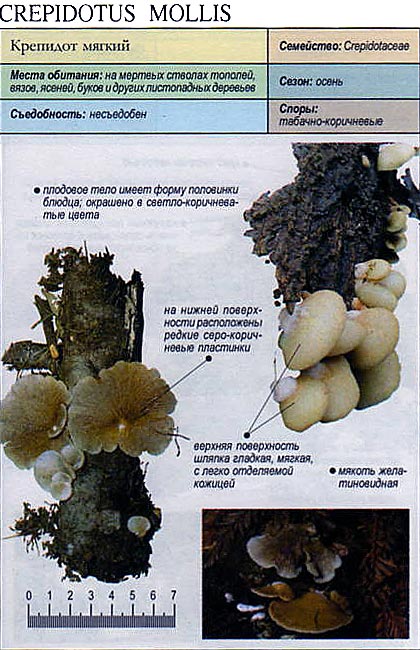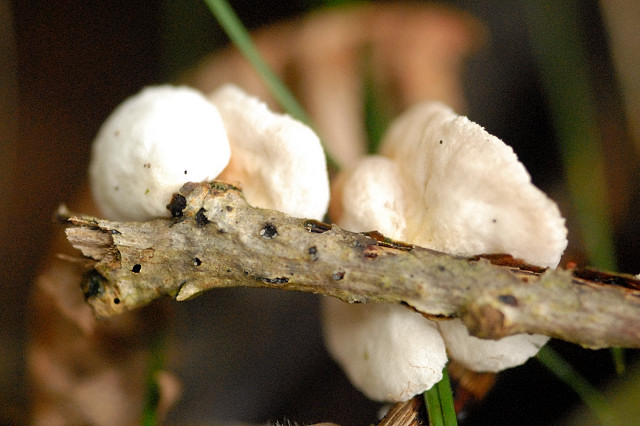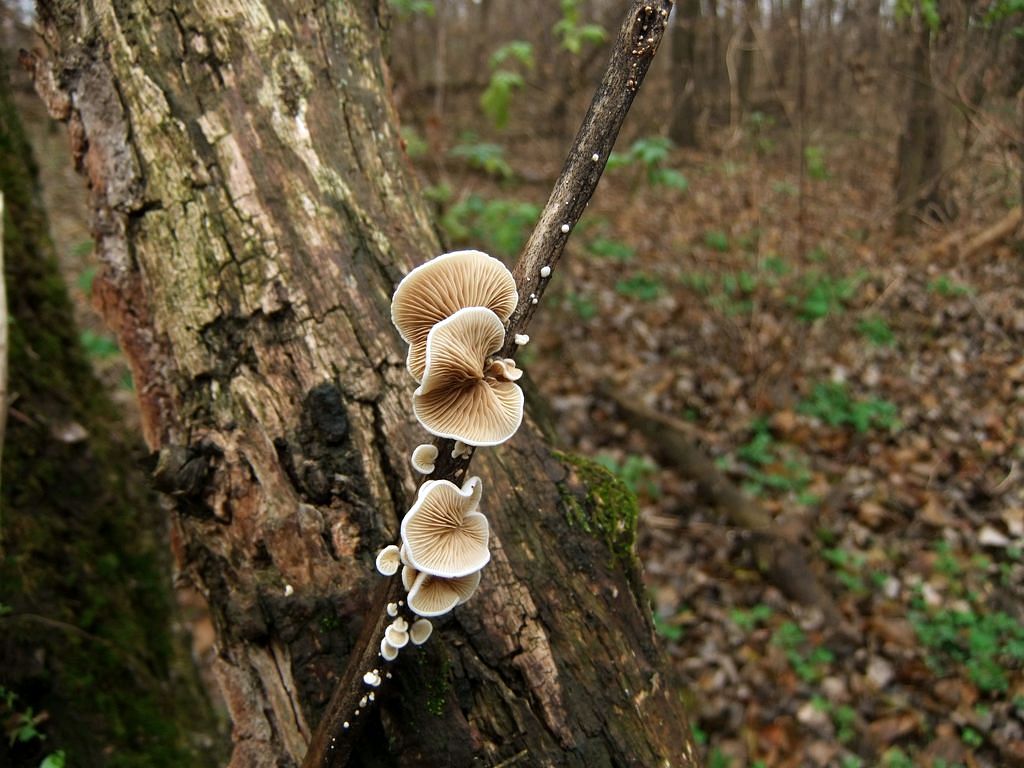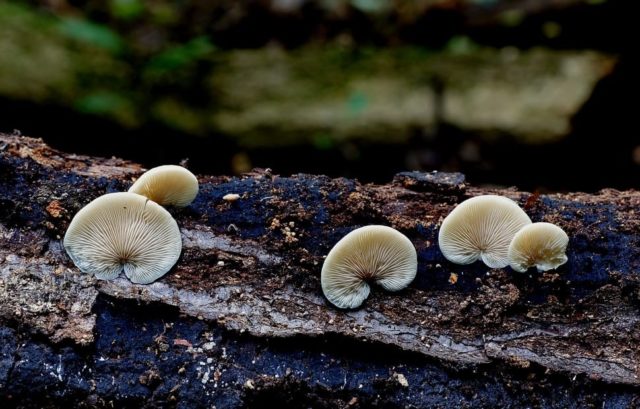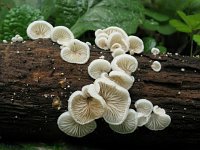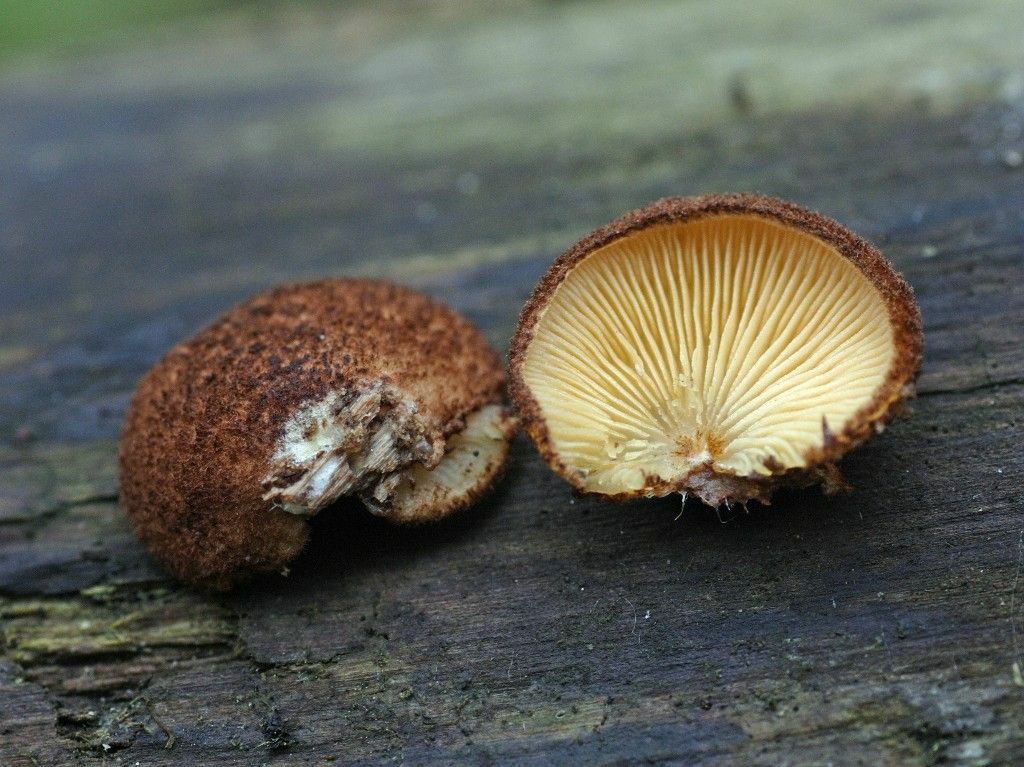Changeable crepidot: description and photo
| Name: | Crepidotus changeable |
| Latin name: | Crepidotus variabilis |
| Type of: | Inedible |
| Specifications: |
|
| Systematics: |
|
Variable crepidotus (Crepidotus variabilis) is a small tree fungus from the Fiber family. Until the beginning of the 20th century, it had other names:
- Agaricus variabilis;
- Claudopus variabilis;
- Claudopus multiformis.
This oyster-shaped fruiting body belongs to the vast species of Crepidots.
What the volatile crepidots look like
These fruiting bodies belong to the Hat variety with a rudimentary or completely absent stem. Attached to the surface of the substrate with the side part or top, plates downwards.
The diameter of the fruiting body is from 0.3 to 3 cm, some specimens reach 4 cm. The shape is an irregular shell or lobe with edges curved in a wave. The cap is whitish-cream or yellowish delicate color, tomentose-pubescent, with a smooth edge, dry, thin, with weakly expressed fibers.
The plates are sparsely located, large, of various lengths, converging to the attachment point. The color is white, after which it darkens to grayish-brown, pinkish-sandy, lilac. There are no bedspreads. The spore powder is green-brown, pinkish, cylindrical in shape, with thin warty walls.
Where the volatile crepidots grow
The fungus belongs to saprophytes. It grows on decaying wood residues: stumps, trunks of fallen trees. Prefers hardwood. Often found in dead wood on thin twigs. It can also grow on a rotten branch or in rotten hollows of a living tree. Grows in large groups, close to each other, less often at a short distance.
The mycelium bears fruit throughout the warm season, from the moment the air warms up to an acceptable temperature, this is May-June, until the autumn frosts.
Is it possible to eat the volatile crepidota
The fruit body has a delicate pulp with a slightly sweetish taste and an unexpressed pleasant mushroom smell. It is not poisonous, no toxic substances were found in the composition. It is classified as an inedible mushroom due to its small size.
How to distinguish Crepidota mutable
The fruit body bears great resemblance to other members of its species. A characteristic feature of each species is the structure of the spores, which can only be distinguished under a microscope. It has no poisonous counterparts.
- Unfolding (versitus). Not poisonous. It is distinguished by a white color, an even shell-like shape with a brown junction.
- Flattened (applanatus). Non-toxic. Watery, moist, the edges of the cap are bent inward, fluffy fibers are located at the site of attachment to the substrate.
- Soft (mollis). It is distinguished by a smoother shape of a cap with scales, a brownish color, an edge at the junction and a very delicate pulp. Comment! Soft crepidote is classified as conditionally edible mushroom. Little known for mushroom pickers because of its small size.
- Cezata. Non-toxic, classified as inedible mushrooms. Differs in sparser and thicker plates, light edging and slightly wavy, slightly curled inward edge.
The volatile crepidote is also similar to the edible oyster mushroom or common. The latter is distinguished by a pronounced elongated attachment point to the substrate, an even rounded cap and larger sizes - from 5 to 20 cm.
Conclusion
Variable crepidote is a miniature tree fungus-saprophyte, found everywhere in Europe, on the territory of Russia and America. Loves shaded places, lives on the remains of representatives of the Notofagus family and other hardwoods.Less often it settles on coniferous wood or in dead woods. Due to its size and low nutritional value, it is classified as an inedible mushroom. No poisonous twins were found in the fruiting body.
Flattened crepidote
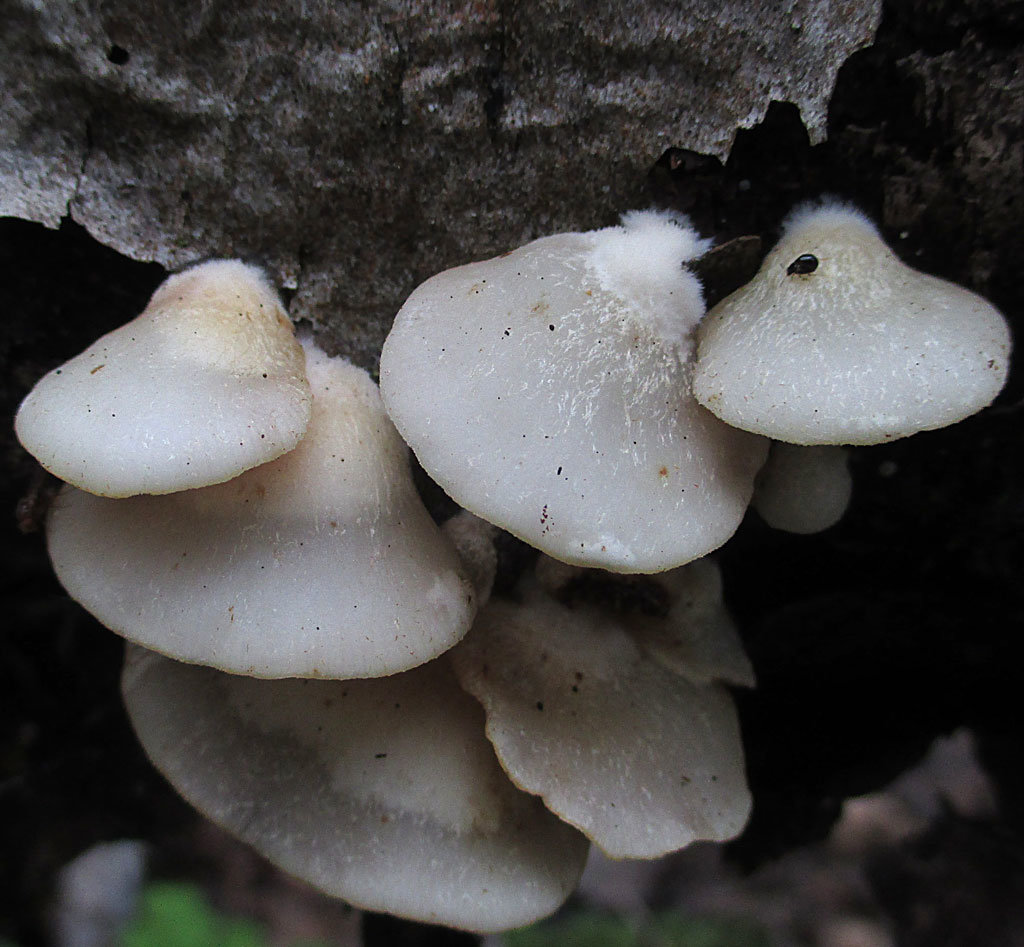
Description
Hat: 1-4 cm, semicircular, shell-shaped or petal-shaped, sometimes, depending on growth conditions, rounded. The shape is convex in youth, then prostrate. The edge may be slightly striped, tucked inward. Soft, somewhat flabby to the touch. The skin is hygrophilous, smooth or finely velvety, especially at the point of attachment to the substrate. Color: white, turns brownish to pale brown with age.
The grimace of the cap, photo in wet weather:
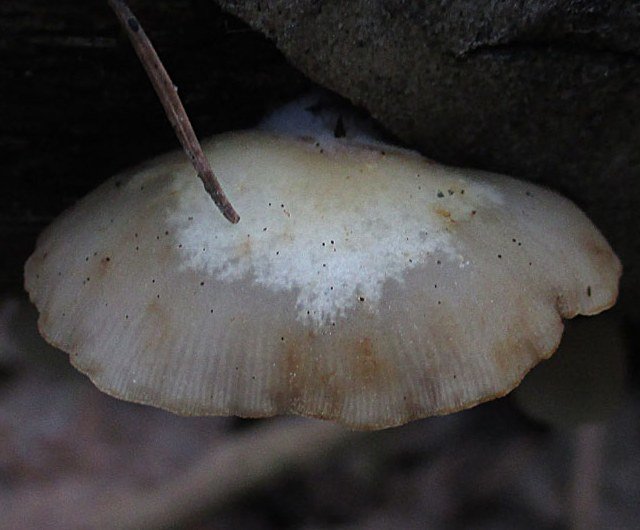
And in a dried state:
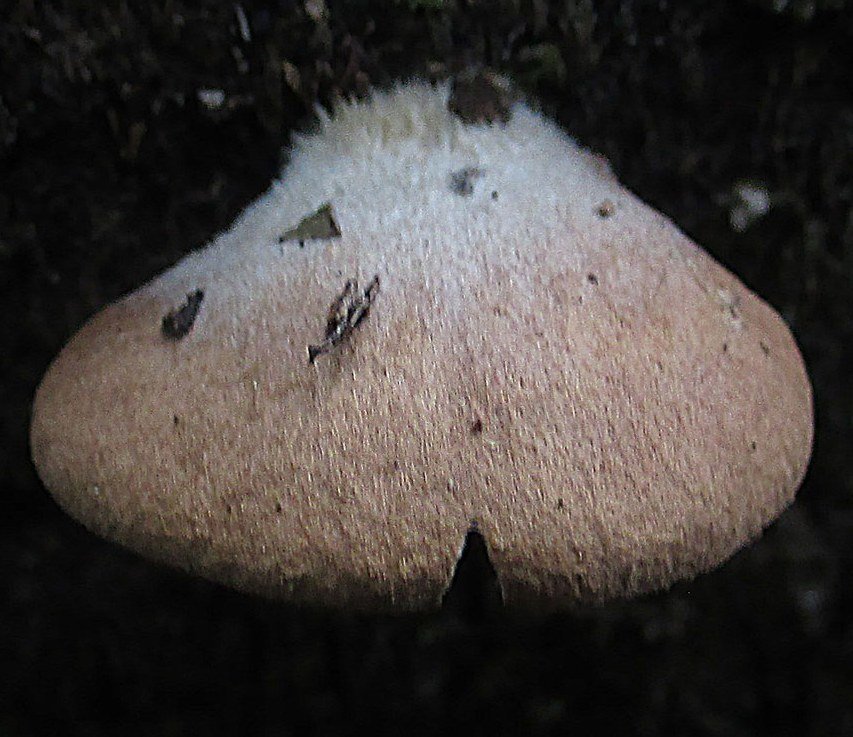
Plates: with an even edge, adherent or descending, rather frequent. Color from whitish to light brown or brownish brown at maturity.
Leg: absent. Rarely, when conditions cause the mushrooms to grow straight up instead of a "shelf", there can be an almost round base of some kind, giving the illusion of a rudimentary "stem" where the mushrooms attach to the tree.
Flesh: soft, thin.
Smell: not pronounced. Taste: pleasant.
Spore powder: Brown, ocher-brownish. Spores: Non-amyloid, yellowish-brownish, spherical, 4.5-6.5 µm in diameter, from finely warty to smooth, with pronounced perispore.
Ecology
As a rule, saprophyte on dead stumps and deciduous logs in deciduous and mixed forests. Less often - on the remains of conifers. Prefers maple, beech, deciduous hornbeam and coniferous spruce and fir.
Similar species
Oyster mushroom (Pleurotus ostreatus) may look similar at a quick glance, but the flattened crepidotus is much smaller. In addition to size, mushrooms are clearly and unambiguously distinguished by the color of the spore powder.
It differs from other crepidots by its smooth and fine-velvety, felt at the base, whitish surface of the cap and by microscopic features.
Stemless mushrooms with a round white cap
Variable crepidotus (Crepidotus variabilis).
Family of Fiber (Inocybaceae).
Season: summer - autumn.
Growth: singly or in small groups in the form of tiled fruit chalk.
Description:
The surface of the cap is tomentose, sometimes smooth on the edge, white or light yellow.
The plates are adherent, relatively frequent, wide, light.
The cap is convex, reniform, rounded, shell-shaped or lobed.
The edge of the cap is tucked up, wavy or lobed, striped.
The pulp is white, with a sweetish taste.
This white round mushroom without a stem does not represent nutritional value due to its small size.
Ecology and distribution:
It grows on dead branches and remains of deciduous wood, less often coniferous species, on small plant debris.
Soft crepidotus (Crepidotus mollis).
Family of Fiber (Inocybaceae).
Season: mid-May - late October.
Growth: in groups.
Description:
The cap is rounded, sessile, at first reniform, later shell-shaped, yellowish, smooth or fine-haired.
The pulp is soft, white or light, odorless.
The leg is lateral, rudimentary, often absent.
Plates are frequent, forked, fan-shaped from the place where the cap is attached to the trunk, light.
Ecology and distribution:
Grows on dead wood, deciduous branches, rarely on conifers. Sometimes this stemless fungus is found on processed wood and in the hollows of living trees.
Oyster mushroom (Pleurotus ostreatus).
Family: Mycene (Mycenaceae).
Season: September - December.
Growth: in groups, often in dense bunches of 30 or more fruiting bodies, growing together at the base; less often - singly
Description:
The plates are rare, thin, descending along the stem, with bridges near the stem, whitish, yellowing with age.
The cap is fleshy, solid, rounded, with a thin edge; the shape is ear-shaped or almost round (especially in the leg).
The pulp is white, dense, in young mushrooms it is soft and juicy, later tough and fibrous.
The surface of the cap is smooth, glossy, often wavy.
The stem is short, sometimes almost invisible, dense, solid, eccentric or lateral, narrowed towards the base, often curved.
Young mushrooms have a convex cap with a curled edge.
Delicious edible mushroom. It is better to collect young white round mushrooms without a stem (cap diameter up to 10 cm); in old mushrooms, the leg is inedible. It is used universally - fresh in soups and main courses, in pickles, etc.
Ecology and distribution:
It grows on stumps, dead wood, dead or live, but weakened, trees of various deciduous (oak, birch, mountain ash, aspen, willow), very rarely - conifers in deciduous and mixed forests, parks and gardens. Cultivated on an industrial scale in many countries, including Russia. Under artificial conditions, it grows on almost any substrate containing cellulose and lignin - sawdust, shavings, bark, paper, straw, reeds, sunflower husk.
Crepidot soft: description and photo
| Name: | Crepidote soft |
| Latin name: | Crepidotus mollis |
| Type of: | Conditionally edible |
| Synonyms: | Chestnut crepidot |
| Specifications: |
|
| Systematics: |
|
Soft crepidote is widespread in Russia and is often found on dead wood. Sometimes it infects living tissues of deciduous trees. Known among scientists as chestnut crepidotus, Crepidotus mollis.
The mushroom belongs to the Fiber family.
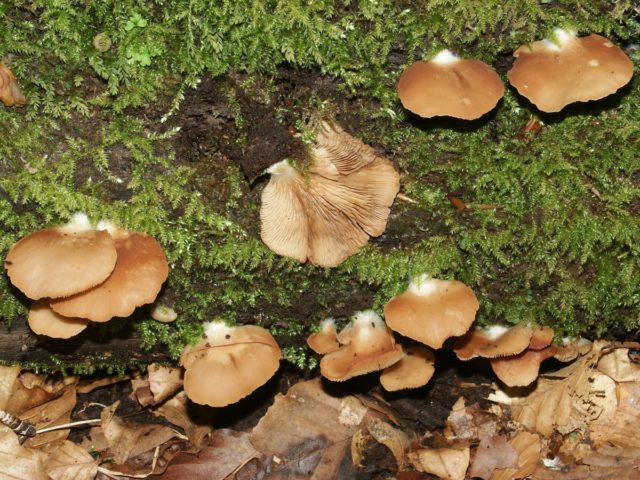
What soft crepidota look like
The sessile cap is reniform at first, from 5 mm. Then it opens, becomes fan-shaped, 5-6 cm in diameter. The hem is wavy, tucked in, furrowed in old specimens. Under the smooth skin, like a gel filling. Color from whitish-cream to dark ocher, yellowish or light brown, chestnut shades.
Narrow, forked plates fan out from the rudimentary stem, sometimes they can be branched. Densely growing plates, adherent to an inconspicuous stem or free-standing. Initially light fawn, then brownish. Mass of buffy spores. The fine pulp has no smell, the taste is pleasant. The peduncle is visible as a small lateral tubercle.

Where soft crepidota grow
Like all members of the genus, the mild species is widespread in Eurasia in the temperate zone, in Africa and South America. It is often found in Russia. Found in the deciduous forests of the Volga region. It also lives on coniferous dead wood and in the affected areas of living trees. Most often, soft crepidot grows on lindens, aspens and other deciduous species. Fruiting bodies are collected in groups. Fruiting from mid-summer to October. Spores can also grow on treated wood. Sometimes crepidote soft is found in the hollows of living trees.
Is it possible to eat soft crepidota
Almost no scientific research has been carried out on the soft species of the Fiber family. Sometimes in the literature there is information that the fruit bodies are inedible. Most scientists classify the mushroom as conditionally edible, of low nutritional value, in terms of quality it belongs to category 4. No toxic compounds have been identified in the fruiting body, but they are used only in extreme cases.
False doubles
Soft crepidote is interesting only for amateur naturalists who identify the types of mushrooms and find it by its relatively large size and gel-like surface. In external structure or color, they are a bit like soft crepidot:
- oyster mushroom orange or nest;
- crepidote changeable;
- crepidote saffron-lamellar.
Orange oyster mushroom belongs to the fourth nutritional category. It is distinguished by a bright color of the skin - orange in various variations of the palette. The flesh of young oyster mushrooms smells like melon, and old caps give off an unpleasant smell, similar to rotten cabbage.
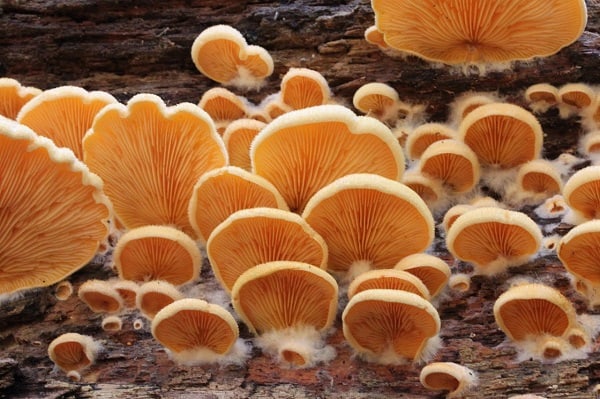
The variable species has very small caps, up to 3 cm, with uneven plates - first whitish, and then creamy brown. Spore mass of tobacco-brown hue. Fruit bodies are free of toxins, but are not considered a good food product due to their small size.

Saffron-lamellar woody mushrooms differ from the soft appearance in that the cap looks like it is covered with scales.

Use
Before using, the caps must be boiled for 10-20 minutes, and then fried. Soft large fruiting bodies are dried, young are pickled.
When eating conditionally edible mushrooms, it must be remembered that such dishes are not recommended in large quantities. The gifts of the forest are digested and absorbed by the body for a long time due to the high content of chitin.
Conclusion
Soft crepidote is a conditionally edible species, widespread. With an abundance of other mushrooms, it is better to refrain from harvesting it.
Mushrooms in the Caucasus
From the section "Travel Tips"
MUSHROOM LIST (scroll down)
Mushrooms in the Caucasus types of mushrooms mushroom pictures mushrooms photo description mushrooms photos photo of mushrooms in the forest quiet hunting mushrooms in pictures mushrooms of the Caucasus mushroom places edible and inedible mushrooms
This section is dedicated to the mushrooms of the North Caucasus. Most of the species of these mushrooms also grow in other regions of Russia, with the only difference that the fruiting season of one or another type of mushroom may be shifted in time, depending on the climatic conditions of the region. Currently, the site contains an incomplete list of mushrooms of the North Caucasus. The section is periodically replenished with descriptions of new types of mushrooms, as they identify with the existing species of these amazing creatures of nature.
Mushrooms represent a separate extraordinary kingdom of living organisms on our planet. The total number of mushroom representatives is estimated at one and a half million. It should be noted that only a small part is made up of large, visible varieties of mushrooms. Such fungi are called macromycetes, they form significant fruiting bodies and are well visible to the naked eye. Fungi reproduce by spores, very often carried by the winds. The underground part of the fungus is called hyphae or mycelium, it is an extensive network of fine filaments.
Each type of mushroom has a scientific Latin name. Popular names are not so reliable, since they differ even within the boundaries of one language. However, it should be borne in mind that there are some discrepancies in the scientific mushroom nomenclature, which suggests that a unified and consistent classification of macromycete fungi has not yet been created. To determine the type of macromycetes, the most important features are their shape, the color of fruit bodies, and structural features.
The most diverse can be the form of the fruiting bodies of macromycete fungi. The vast majority of them, which are of gastronomic interest, have fruiting bodies with caps. Often, the texture of the surface of its cap (covered with scales, smooth, velvety, etc.) and the shape of the edge of the cap (bent, flat, streaked, torn, etc.) can play a significant role in determining the mushroom. An equally important criterion is the plates - the structure and their method of attachment to the stem.
The plates can be adherent, free or creeping down to the stem of the mushroom. There are also plates that may have a notch or notch at the point of attachment to the mushroom stem (in another way teeth adhered to”). The plates can be sparse and frequent, branched, varying in length, or equal. Separate similar species of macromycetes can only be recognized by the color of their spore powder.
Fruiting bodies are necessary for fungi for one single purpose - to spread spores. Many of them, in addition, are a delicious dish for both humans and animals. In the course of their evolution, most of the cap mushrooms received protective features - toxins, thanks to which some of their mass became deadly poisonous. However, many types of cap mushrooms are completely harmless to humans. Therefore, they can be collected and eaten, observing only one elementary condition: do not pick mushrooms that are unfamiliar to you.Only after making sure of the absolutely correct definition of the species belonging of the mushroom, you can afford to appreciate all its taste. But it should also be remembered that some of the edible mushrooms may have poisonous "counterparts", in terms of the totality of signs, surprisingly reminiscent of their non-poisonous counterparts. Acquaintance with the diverse and interesting world of macromycete mushrooms, the ability to distinguish all the subtleties in a species can give a person real pleasure and arouse genuine admiration for the inexhaustible beauty of natural forms.
Some species
- Crepidotus albescens (Murrill) Redhead 1984
- Crepidotus alveolus (Lasch) P. Kumm. 1871
- Crepidotus apodus Capelari 2006
- Crepidotus applanatus (Pers.) P. Kumm. 1871 - Flattened Crepidotus
- Crepidotus autochthonus J.E. Lange 1938
- Crepidotus boninensis (Hongo) E. Horak & Desjardin 2004
- Crepidotus brunswickianus Speg. 1887
- Crepidotus calolepis (Fr.) P. Karst. 1879 - Crepidotus beautiful scaly
- Crepidotus candidus Capelari 2006
- Crepidotus carpaticus Pilát 1929
- Crepidotus caspari Velen. 1926
- Crepidotus cesatii (Rabenh.) Sacc. 1877 - Crepidotus Caesatus
- Crepidotus cinnabarinus Peck 1895
- Crepidotus cristatus Senn-Irlet & Immerzeel 2003
- Crepidotus crocophyllus Berk. - Crepidotus saffron-lamellar
- Crepidotus epibryus (Fr.) Quél. 1888
- Crepidotus fulvifibrillosus Murrill 1917
- Crepidotus improvisus (E. Horak) T.W. May & A.E. Wood 1995
- Crepidotus longicomatus Har. Takah. 2003
- Crepidotus luteolus (Lambotte) Sacc. 1887 - Yellowish Crepidotus
- Crepidotus mollis (Schaeff.) Staude 1857 - Soft Crepidotus
- Crepidotus muscigenus Velen. 1947
- Crepidotus nanicus E. Horak 1978
- Crepidotus nephrodes (Berk. & M.A. Curtis) Sacc. 1887
- Crepidotus novae-zelandiae Pilát 1950
- Crepidotus nyssicola (Murrill) Singer 1973
- Crepidotus parietalis E. Horak 1978
- Crepidotus paxilloides Singer 1951
- Crepidotus pezizoides (Nees & T. Nees) P. Kumm. 1871
- Crepidotus rubrovinosus Bandala, Montoya & E. Horak 2006
- Crepidotus stenocystis Pouzar 2005
- Crepidotus subverrucisporus Pilát 1949 - Rough-spore Crepidotus
- Crepidotus thermophilus (Singer) Aime, Baroni & O.K. Mill. 2002
- Crepidotus variabilis (Pers.) P. Kumm. 1871 - Crepidotus mutable
- Crepidotus versutus (Peck) Sacc. 1887 - Crepidotus unfolding
- Crepidotus virgineus Har. Takah. 2003
How to distinguish edible from poisonous rows and their description (+37 photos)
Ryadovki is a genus of lamellar mushrooms that belong to the Ryadovkov (Tricholomov) family. People call them "paths" for the property to grow in a row. Mushrooms are widespread, but only some species are eaten, therefore, before going to the collection of rows, you must familiarize yourself with the description and photos of edible rows so as not to pick up bad mushrooms in the basket.
Characteristic features of the type and collection rules
The genus includes species of all mushroom categories, from edible to poisonous. The following general features are characteristic of the rows:
- fleshy convex cap, acquiring a flattened shape with aging;
- cracked edges;
- the presence of plates;
- cylindrical leg;
- thick pulp;
- powdery odor in many species.
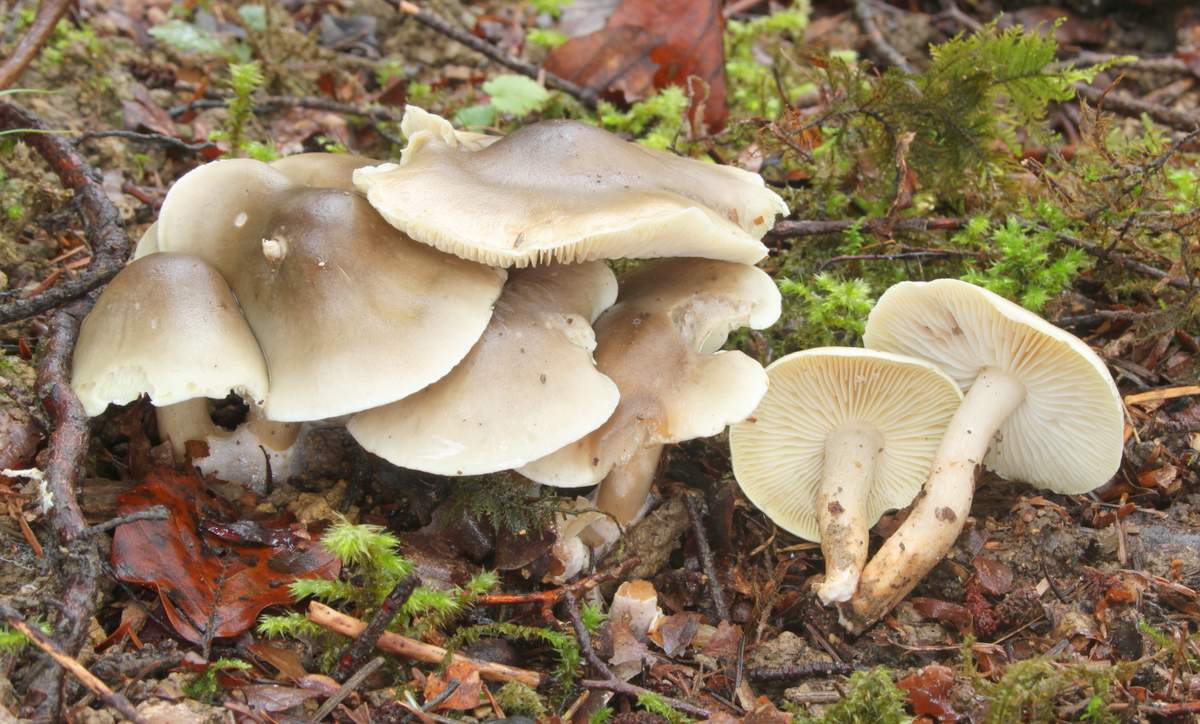





It is best to collect tracks in the first half of autumn. It is not difficult to look for mushrooms, because they grow in a row and in large groups. You can distinguish between edible and poisonous species by their appearance, smell, or the reaction of the pulp to air.
What species are considered completely edible?
Autumn edible rows are represented by the following types:
- Pigeon (pigeon). Doves have white fleshy caps with a cracked edge. They are in the shape of a hemisphere. The surface is slippery, sticky. The leg is bent. The surface of the stem is white, but specimens with a greenish base can be found. The plates are wide, white.









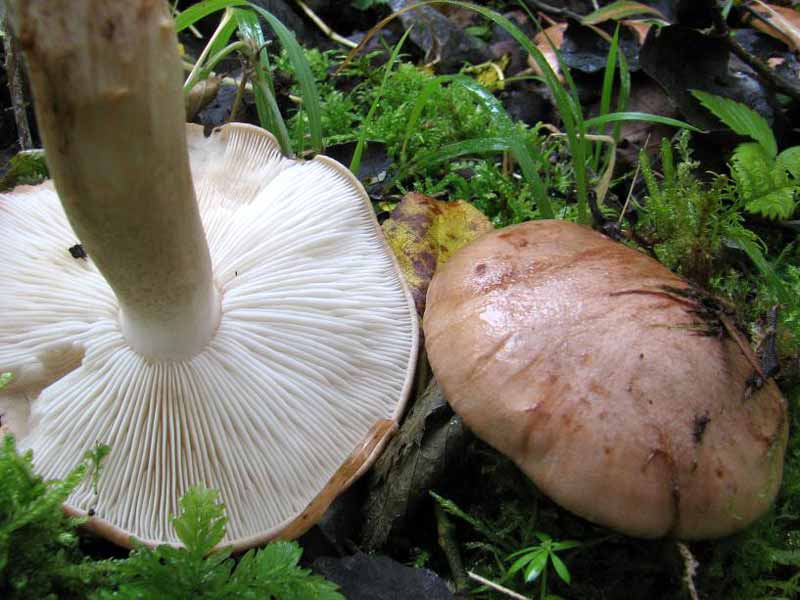


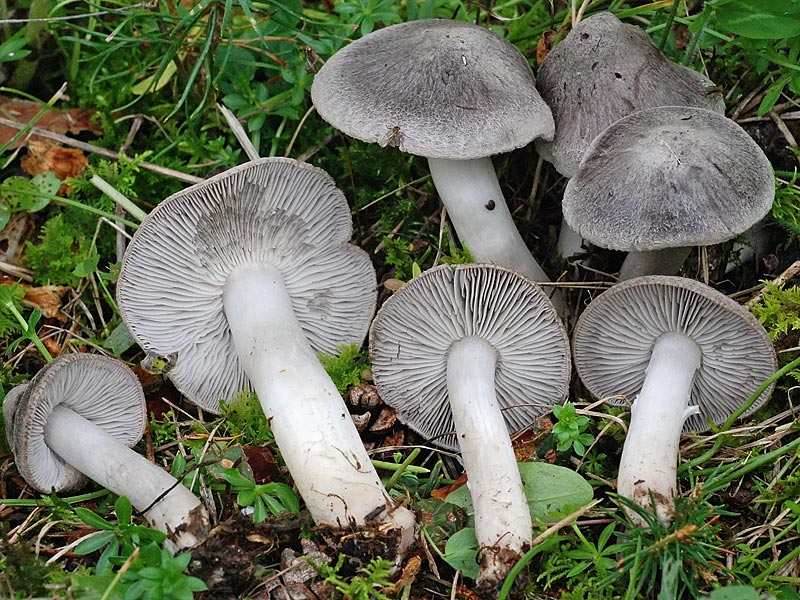






Conditionally edible ryadovka mushrooms
The category of conditionally edible mushrooms includes the following types of rows:
- silvery (scaly greasy);
- golden;
- shod;
- scaly (sweetener);
- yellow-red;
- bearded;
- greenfinch.
On the territory of Russia, the most common are:
- The scaly row has a convex or flat-convex cap. A tubercle is visible in the middle. The surface of the hat is velvety, chocolate-colored. The leg is club-shaped. From above it is painted white, and from below it has a pink-brown or yellow-brown color. The pulp can be either white or creamy. At the break, it gives off a faint fruity aroma.




Poisonous species and differences from edible
Eating poisonous ryadovki is very dangerous for human health. These include the following types:
- spruce;
- white;
- toad;
- smelly;
- conical (pointed);
- brindle (leopard);
- spotted;
- scorched (tanned).
Edible species can only be confused with white, spotted and leopard rows. You can distinguish them like this:
- The white ryadovka is distinguished by a snow-white, sometimes yellowish color. The hat is open and velvety. The leg is cylindrical, slightly curved. Its surface repeats the color of the cap.You can recognize the mushroom by its pulp. It tends to change its color upon contact with air, therefore, at a break, it instantly turns pink. A sharp unpleasant smell of radish emanates from the pulp.

Answers to common questions
The paths are often the topic of discussions for mushroom pickers. Below is a list of the most frequently asked questions about rows with answers to them:

